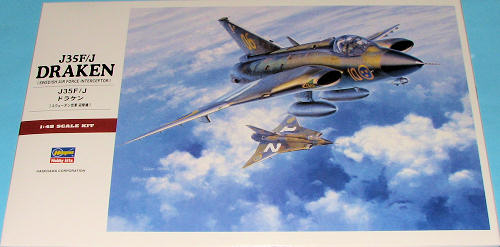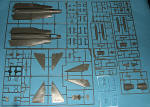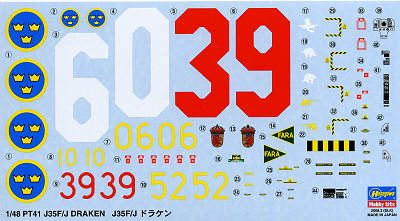
Hasegawa 1/48 Saab J.35F/J Draken
| KIT: | Hasegawa 1/48 Saab J.35F/J Draken |
| KIT #: | 07241 |
| PRICE: | 3600 Yen from www.hlj.com |
| DECALS: | Three options |
| REVIEWER: | Scott Van Aken |
| NOTES: | New mold kit |

| HISTORY |
As the jet era started, Sweden foresaw the need for a jet fighter that could intercept bombers at high altitude and also take on fighters. Although other interceptors such as the US Air Force's F-104 Starfighter were being conceived during the same period, Saab's "Draken" would have to undertake a combat role unique to Sweden. Other demanding requirements were the capability to operate from public roads, used as temporary airfields and for refueling/rearming to be carried out in no more than ten minutes, even by conscripts with minimal training. In September 1949, the Swedish Defence Materiel Administration issued a request for a fighter/interceptor aircraft, and work began at Saab the same year.
Draken's design incorporated a distinctive "double-delta" configuration, with one delta wing within another larger delta. The inner wing has an 80° angle for high speed performance, while the outer 60° wing gives good performance at low speeds. Propulsion was provided by a single Svenska Flygmotor RM 6B/C turbojet (Rolls-Royce Avon 200/300). A ram turbine, under the nose, provided emergency power and the engine had a built-in emergency starter unit. The Draken could deploy a drag chute to reduce its landing distance.
The double-delta shape was so revolutionary that it warranted the only sub-scale test aircraft built in Sweden: the Saab 210, unofficially nicknamed "Lilldraken" (the little kite). The Saab 210 tested the concept of the double delta, first flying on 21 January 1952. The 210's successful testing results led to an order for three full-size Draken prototypes. The first prototype, not fitted with an afterburner, made its maiden flight on 25 October 1955. The second prototype, equipped with an afterburner, on its first flight, unintentionally broke the sound barrier while climbing.
Although not designed to be a dogfighter, the J 35 Draken proved to have good instantaneous turn capability and was a very capable fighter. It entered service in 1960 with the Swedish Air Force; 644 Saab Drakens were built for Sweden as well as other European nations. Sweden's Draken fleet came in six different variants while two Draken models were offered for export. The early models were intended purely for air-defense. The last model built was the J 35F, the final variant to remain in Swedish service. These aircraft have now been retired and replaced by the Saab Gripen.
The J 35 Draken design underwent several upgrades. The last was the J 35J version, in the late 1980s, although by then, the Draken had been almost totally replaced by the Saab Viggen in Swedish service. The J 35J was a service-life extension program since the delivery of the new Saab JAS 39 Gripen was still in the development stage and suffering from delivery delays. The extension program was to keep the Draken flying into the 2000s, but due to cutbacks and high maintenance costs the Draken was eventually phased out. The Swedish Drakens were officially retired in December 1998, although the type remains in limited numbers in both military and civilian versions. Export customers included Denmark and Finland. In 1985, the Austrian Air Force purchased 24 J 35D s totally reconditioned by Saab, designnated J 35Ö.
All Drakens are interceptors with limited air-to-ground capability, with the sole exception of the Danish Drakens, which are strike aircraft capable of carrying AGM-12 Bullpup missiles, advanced "jammers", and increased internal and external fuel stores. The Danish Drakens are so far the heaviest of the series to have been in service. Danish F-35 aircraft were retired in 1993.
Finland updated its 35X fleet with new avionics, cockpit displays, navigational/attack systems and electronic countermeasures during the 1990s but finally retired the Draken in 2000.
Austria was the last country to operate the Draken in military service. They bought refurbished J 35D which was the last variant with two internal cannon due to the Austrian restriction of not being allowed to carry air-to-air missiles. These Drakens were retired in 2005, when they were replaced by former Swiss Tiger IIs, while waiting for new Eurofighters.
In the United States, the National Test Pilot School (NTPS) owns six Drakens that were formerly in Danish service; of these, two TF-35XD s and one RF-35XD are operational, based at the Mojave Spaceport.
| THE KIT |
 A real surprise to most modelers when announced a while back, the 1/48 kit has much of the look of the much earlier 1/72 variant, a kit that seems to disappear from the shelves with much speed when new boxings are done. There is probably only one good way to mold a Draken kit, and that is with separate upper and lower fuselage halves. The fin and end wing sections are separate and come in two halves.
A real surprise to most modelers when announced a while back, the 1/48 kit has much of the look of the much earlier 1/72 variant, a kit that seems to disappear from the shelves with much speed when new boxings are done. There is probably only one good way to mold a Draken kit, and that is with separate upper and lower fuselage halves. The fin and end wing sections are separate and come in two halves.
The cockpit is well done with raised detailing and the option that many of us choose; to install the decals provided over the top of them. Separate rudder pedals and side insets are provided for the cockcpit as well as a nicely done four piece bang seat, which is wisely shown being installed in the last construction step. There are holes to open up for the J model behind the intakes for the missile rails and one is provided with an AIM-4D Falcon or two different Sidewinder variants. Also needing opened are holes for the drop tanks if one wants to use them.
The kit provides inserts for the leading edge of the inner wing section to take care of the cannon (which are not used on this boxing) and on the spine for coolant intakes. The engine intakes are a single piece and very well molded. Weight is required and will fit into the two piece nose cone. Drakens had a tail wheel to prevent striking the rear fuselage on takeoff and this was normally down on the ground.
 Molding is what one would expect from Hasegawa and is excellent. This also means that you will find ejector pin holes or mini-towers on the landing gear legs, on one side of all the pylons, and on the one-piece nose wheel. Why Hasegawa is unable to eliminate all these markings has always been a puzzle.
Molding is what one would expect from Hasegawa and is excellent. This also means that you will find ejector pin holes or mini-towers on the landing gear legs, on one side of all the pylons, and on the one-piece nose wheel. Why Hasegawa is unable to eliminate all these markings has always been a puzzle.
Instructions are superb and provide the now no-longer-imported Gunze paints. FS 595 numbers are provided for some of the exterior finish colors. Markings are for two planes. One is the box art plane from Div 3/F10 in Olive Drab and Midnight Blue over Neutral Grey with bare metal leading edges to the flight surfaces and a major portion of the underside of the fuselage. Two different planes from this unit are provided, one being an F version with large white numbers on the upper wing and the other a J without the big numbers. The third is from Div 2/F10 and is a J model in the greys of 36230 over 36622. This one has the large day-glo upper wing numbers. the decal sheet is excellent and has true whites and reds. Hasegawa has also done a great job on the day-glo lettering as it is quite brilliant.
| CONCLUSIONS |
One wouldn't have thought that an aircraft like this would engender a lot of interest, but I'll bet it sells very well indeed. It certainly comes in a large enough box and if anything like their 1/72 version, will be a real beauty. I'm sure there will be boxings for Finnish and Austrian and Danish planes in the works.
| REFERENCES |
April 2008
My thanks to www.hlj.com for the review kit. Get yours today at Japanese prices. If you would like your product reviewed fairly and fairly quickly, please contact the editor or see other details in the